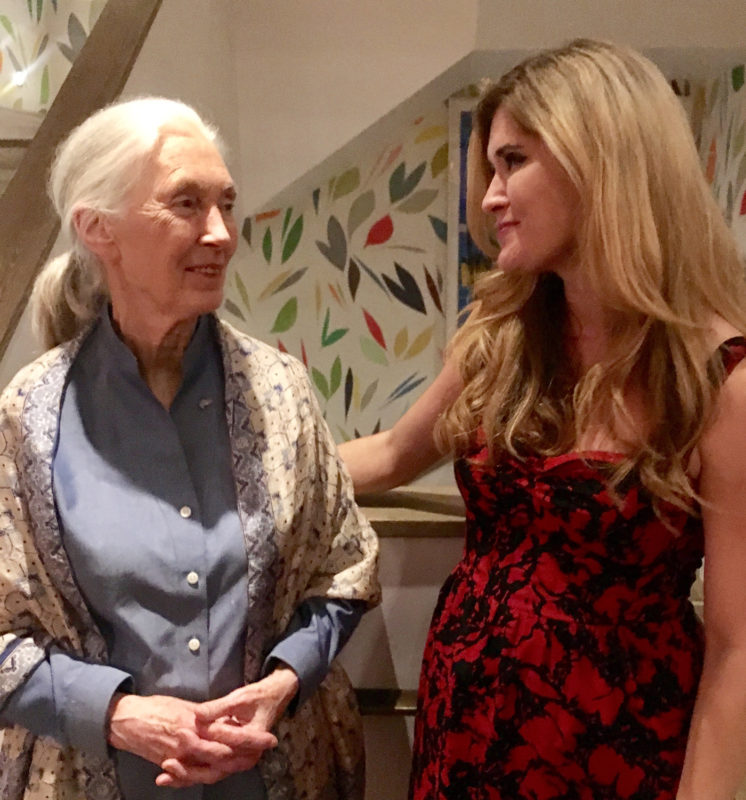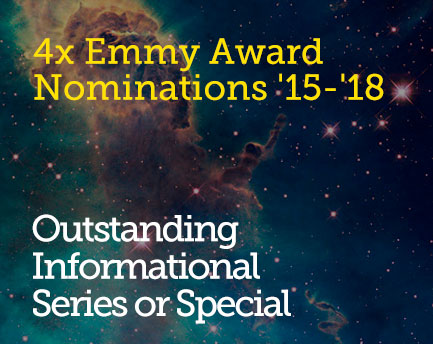October 20, 2017 9:05 pm
JANE, AKA the Best Film of 2017, Stars an 83-Year-Old Female Scientist – Take That, Hollywood!
Today’s guest post is by Natalia Reagan, primatologist, anthropologist and StarTalk All-Stars host.

“Just two blonde bipedal primates making eyes (and NO, those aren’t tears in mine).” Photo credit: Lindsey Walker.
Good news, everyone! The best film of 2017 has arrived. It stars a female scientist and includes copious amounts of fascinating chimpanzee footage.
Seriously. I’m not kidding. Go see JANE now. Like, right now.
As a primatologist, I was thrilled to receive an invitation to the NYC premiere of the film JANE.
Not only were they screening the film, but Jane Goodall herself was going to be there! Who can say no to a night of hanging in the same room with your hero? Not, moi!
Furthermore, JANE was directed by Academy Award nominated documentary filmmaker Brett Morgen. Morgen has been dubbed the “Mad Scientist” of documentary filmmaking by the New York Times, and most recently directed the critically acclaimed Kurt Cobain documentary “Montage of Heck.” (Go see that, too.)
Given the subject and the auteur of JANE, this film was destined to be great. But hadn’t the world seen enough content about Jane Goodall? (That’s sacrilege if you ask me!)
Goodall has been the subject of countless books, articles, and films during her nearly 60-year career as a primatologist. Each one beautifully detailed her life amongst chimpanzees. So it seemed every aspect of Jane’s life had been properly covered and celebrated on page and screen.
Then comes JANE.
The film tells the story of Jane Goodall’s life using never before seen footage that had spent decades in the vaults of National Geographic. Renowned composer Philip Glass provides the superb soundtrack to this atypical love story that follows not the love between Jane and her husband Hugo (though the film goes there too) – but between Jane and her work with chimpanzees.
It is a miracle the film was ever made. I had the pleasure of chatting with the film’s director and, according to Morgen, “The filmmaker and the subject had no interest in making this film for the same reason, we both felt there had been a plethora of Jane Goodall films and there was nothing left to say on the subject.” He went on to say, “There had been a lot of films in which Jane described her experiences but no film that allowed her audience to experience it firsthand – that is unique to cinema.”
He’s right. During the first twenty minutes of JANE the entire audience looked like they had just spent the afternoon “cutting onions.” Jane’s thoughtful and descriptive voiceover, coupled with the dramatic footage of Lake Tanganyika and lush hills of Gombe, immediately transported the audience into Jane’s new adventure. We left the little theater in Midtown for a moment and were transported to Tanzania feeling her excitement, wonder, and a sense of being ‘home.’ Or at least that’s what this incredibly biased primatologist felt.
If you’d like to listen to the interview, here it is:
The story is familiar: In 1960, Goodall was sent by Dr. Louis Leakey to study wild chimpanzees in Tanzania. At the time Goodall was Leakey’s secretary and had no formal scientific training. What she lacked in education she made up for with passion, dedication, and ingenuity. And the film reveals a previously missing piece of Jane’s story: Vanne Morris Goodall, Jane’s mother.
Vanne had accompanied Jane to Gombe in the beginning of her research to be her companion during an era when young women did not travel alone. However, Vanne was much more than a companion. She provided constant support and was an avid advocate for Goodall’s work. Morgen said he hopes “that parents recognize and understand Vanne’s contribution to Jane’s work. What Vanne did that was so valuable was to listen. She did not try to impose her values or her ideas on Jane – she was able to identify with Jane and support her for who she was.”
The film details Goodall’s frustration as she struggled to get closer to her subjects, the chimps. The chimps kept their distance, but as she spent more time with them they became habituated to her presence. David Greybeard was the first brave chimp to interact with this strange, bipedal blonde. It took time, patience, and immersion into their world to become accepted by the chimps at Gombe, but soon they all accepted Jane into their fold.
When asked about his filmmaking process, Morgen stated that his techniques are not so different from Jane’s. During his early years as a documentarian, he realized the best way to tell a story is through complete immersion. Morgen saw that, “Embracing the subjective was a pathway to achieving a higher truth.” This is evident as he allowed Jane’s own words, combined with husband Hugo’s footage, to tell her story.
As a primatologist, I was impressed by the film’s multi-dimensional look at chimpanzee behavior: from the loving nurturing mother, Flo, to inter-group violence, to goofy play between infants. The film shows how vastly more similar humans are to chimpanzees than different. We are not-so-distant cousins after all.
The film also delves into the difficult aspects of Goodall’s experience with the chimps, including a polio outbreak that killed several chimpanzees at her research site. Humans possibly brought the disease to the site and Morgen asks Goodall if she or her students could have been the culprits. Morgen did not approach the film or Goodall with kid gloves, but rather as a storyteller capturing all aspects of Jane’s story.
“I wasn’t a huge Jane Goodall fan going into it and I think that was actually a blessing. And I also think that Jane Goodall was not a Brett Morgen fan and I think that really helped make the film what it is.”
Just like Jane’s lack of scientific training may have helped her approach the study of chimpanzees with fresh eyes, so did Morgen’s lack of fandom. Because he didn’t revere Jane like say, oh, a primatologist who sees her as a demi-god, Morgen was able ask harder hitting questions without hesitation.
JANE also tells the love story between Goodall and wildlife photographer, Hugo van Lawick. Hugo had come to photograph Jane at Gombe and the slow burn of their romance is another highlight of the film. Footage from their time together at Gombe is used to tell their love story, from Goodall’s initial annoyance of van Lawick’s presence, to her softening over time. Soon, they realized it was love and they married and had Grub, a son.
As Morgen puts it, “I’m so exited to tell a story about a woman who’s doesn’t have to give up her dreams to be a mother and a wife.” Goodall defied the antiquated notion that women can’t have it all.
However, both Goodall and van Wick were each in love with their respective careers. They were also the best in their fields. Goodall had worked too hard to give up her work and tough decisions were made. As Morgen explains, “The movie was called ‘In The Shadow of Man’ until a month before the premiere. When Jane wrote the book ‘In the Shadow of Man’ Jane was referring to the chimps. When I was producing the film, I thought of it as she had to get out the shadow of Leakey and Hugo in order to become whole.”
It’s a story many woman can relate to: having to not only balance career, partnership, and motherhood, but also to escape the shadow of man, so they too can feel the sun on their face.
And that is exactly what Jane Goodall did.
JANE is a breathtakingly beautiful film that will surely inspire hearts young and old. Morgen took great care to tell JANE’s story through her perspective, abandoning any objectivity.
I hope to see the field of primatology continue to grow in the wake of this stunning portrayal of a modern day hero. This film is exactly what we need in 2017. A story that focuses on a strong, resilient female scientist fulfilling her dreams…and falls in love along the way.
That is JANE.
(Why are you still sitting here? Go see it!)
Get the most out of StarTalk!
Ad-Free Audio Downloads
Ad-Free Video Episodes
Stickers & Mugs
Live Streams with Neil
Priority Cosmic Queries
Early-Access Videos
Learn the Meaning of Life
...and much more

 Become a Patron
Become a Patron

